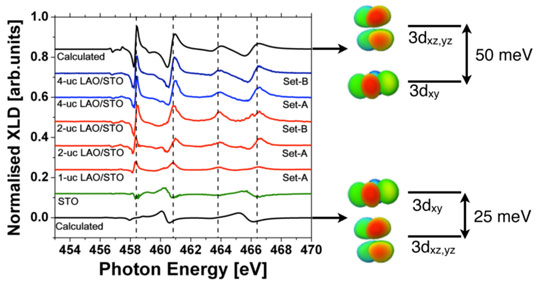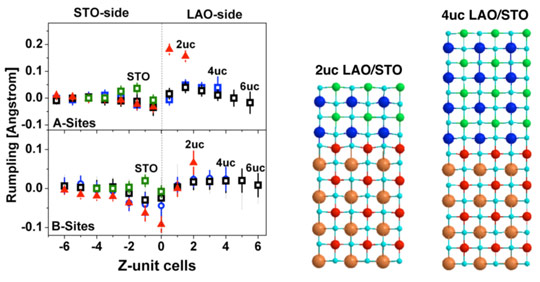- Home
- News
- Spotlight on Science
- Structural and electronic...
Structural and electronic reconstruction at the interface between LaAlO3 and SrTiO3 band insulators revealed by X-rays
27-03-2013
The interface between two of the most popular band insulating oxides, LaAlO3 and SrTiO3, is conducting under certain conditions due to the formation of a high mobility 2D-electron gas, a discovery made in 2004 by Ohtomo and Hwang [1]. Here, by using a combination of advanced X-ray synchrotron-based spectroscopic and structural measurements, we show that this phenomenon is linked to a structural and electronic reconstruction of the interface which precede the appearance of the 2D-electron gas. The results challenge some of the most accredited theoretical models describing this system.
Share
Nowadays, the latest advances in the atomic control of epitaxial heterostructures means that interfaces with perfection down to the atomic scale can be obtained even in complex oxides [1]. As a consequence of these technological achievements, new functionalities, not present in any of the constituent elements in isolation, were discovered in heterostructures made of transition metal oxides (TMO). The most spectacular example is the formation of a 2D-electron gas in LaAlO3/SrTiO3 (LAO/STO) bilayers, composed by thin epitaxial LaAlO3 (001) films deposited on a SrTiO3 single crystal [2-4]. In view of their large band gaps, the realisation of a conducting system at the LaAlO3/SrTiO3 interface was unexpected. The phenomenon is attributed to the transfer of electrons from the polar LaAlO3 (001) surface to the SrTiO3 conduction band, and simultaneous change of the valence of titanium ions, a mechanism which is common to many other transition metal oxide heterostructures [5]. This charge transfer can avoid a 'polarisation catastrophe' as the thickness of the polar LaAlO3 (001) film exceeds a threshold of four unit cells. If this mechanism is proven, it could lead to a general method for creating devices where functionalities could be added at will by interface-engineering.
The 'polarisation catastrophe' picture predicts simultaneous electronic and structural reconstruction of the interface SrTiO3 layers as a consequence of the formation of a mobile 2D-electron gas. With the aim to definitively verify these theoretical predictions, we have performed a series of high resolution synchrotron radiation based X-ray diffraction and X-ray spectroscopy experiments on LAO/STO bilayers deposited by pulsed laser deposition at the University of Geneva (group of Prof. J.-M. Triscone) and at the University of Augsburg (group of Prof. J. Mannhart). X-ray absorption spectroscopy and related X-ray linear dichroism measurements were performed at ID08, the ESRF’s soft X-ray beamline for polarisation-dependent studies. Grazing incidence X-ray diffraction (GXID) experiments were conducted at ID03, the surface diffraction beamline. In Figure 1 we present X-ray linear dichroism (XLD) measurements at the L2,3 edge of titanium ions on insulating (LAO thickness lower than 4 unit cells) and conducting (t >= 4 unit cells) LAO/STO bilayers. The XLD data, acquired in the total electron yield mode, provide information about the splitting of the 3d levels at the interface, and in particular it evidences an inversion of the hierarchy of in-plane and out-of plane orbitals in the case of LAO/STO bilayers compared to an insulating SrTiO3 surface, which is a signature of an electronic (orbital) reconstruction taking place within the SrTiO3 layers close to the interface. As we can see from Figure 1, both insulating and conducting LAO/STO show this electronic reconstruction, demonstrating that it precedes the formation of the 2D-electron gas.
In Figure 2, on the other hand, we show the outcome of the structural refinement obtained from the fit of the crystal truncation rods (CTR) measured by GIXD. The main result concerns the evolution of the rumpling of the AO (A=La, Sr) and BO2 (B=Al, Ti) planes as function of the nominal LAO thickness. This rumpling can be interpreted as a polar response of the STO layers to an internal electric field. The data show that large rumpling of the planes are observed below the critical thickness in both LAO and STO layers, while above the structural distortions are reduced. While this behaviour is qualitatively in line with the predictions of the 'polar catastrophe' picture for the LaAlO3 layers, the SrTiO3 planes are distorted before the formation of a mobile 2D-electron gas and not after, at variance with the models [6]. Overall, the results indicate that both electronic and structural reconstructions, taken as signatures of the validity of the "polar catastrophe" scenario, occur below the nominal critical thickness of 4 unit cells, i.e. before the appearance of a conducting state. In particular, we find that the main structural and electronic changes in STO take place already when one complete LaAlO3 layer is deposited. The results show that the orbital reconstruction, and the appearance of simultaneous polar distortions in STO, are due to a combination of interface symmetry breaking and of the transfer of localised electrons to interface states before the realisation of a mobile 2D-electron gas.
To conclude, it appears that the interface polar discontinuity is only one of the ingredients ruling the physics of the LAO/STO system. Furthermore, it is necessary to consider the surface and interface properties of the constituent materials in the heterostructures, and in this specific case, the interesting properties of STO surfaces.
Principal publication and authors
M. Salluzzo (a), S. Gariglio (b), X. Torrelles (c), Z. Ristic (a,d), R. Di Capua (a), J. Drnec (f), M. Moretti Sala (f), G. Ghiringhelli (e), R. Felici (f), N.B. Brookes (f), Advanced Materials (2013).
(a) CNR-SPIN and Department of Physics, Complesso Monte Sant'angelo, Napoli (Italy)
(b) Département de Physique de la Matière Condensée, University of Geneva (Switzerland)
(c) Institut de Ciencia de Materials de Barcelona (CSIC) (Spain)
(d) Laboratory of Atomic Physics, Institute of Nuclear Sciences Vinča, University of Belgrade (Serbia)
(e) CNR-SPIN and Department of Physics Politecnico di Milano (Italy)
(f) ESRF
References
[1] A. Ohtomo, D.A. Muller, J.L. Grazul, & H.Y. Hwang, Nature 419, 378 (2002).
[2] A. Ohtomo & H.Y. Hwang, Nature 427, 423–426 (2004).
[3] N. Reyren S. Thiel, A.D. Caviglia, L. Fitting Kourkoutis, G. Hammerl, C. Richter, C.W. Schneider, T. Kopp, A.-S. Rüetschi, D. Jaccard, M. Gabay, D.A. Muller, J.-M. Triscone, J. Mannhart, Science 317, 1196 (2007).
[4] S. Thiel, G. Hammerl, A. Schmehl, C.W. Schneider & J. Mannhart, Science 313, 1942 (2006).
[5] S. Okamoto and A.J. Millis, Nature 428, 630 (2004).
[6] S.A. Pauli, S.J. Leake, B. Delley, M. Björck, C.W. Schneider, C.M. Schlepütz, D. Martoccia, S. Paetel, J. Mannhart, P.R. Willmott, Phys. Rev. Lett. 106, 036101 (2011).
Top image: When two-band insulating oxides form a 2D-metal at their interface: X-rays reveal the nature of the electronic and structural reconstruction at the LaAlO3/SrTiO3 interface.





